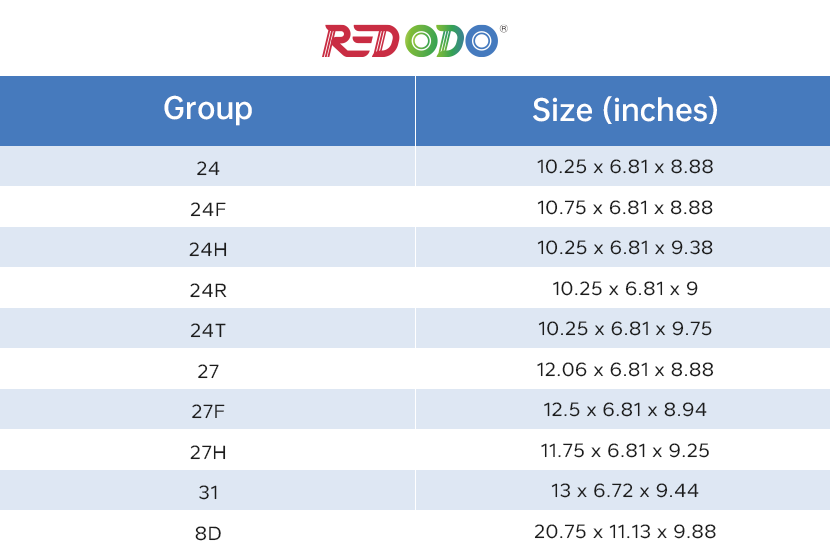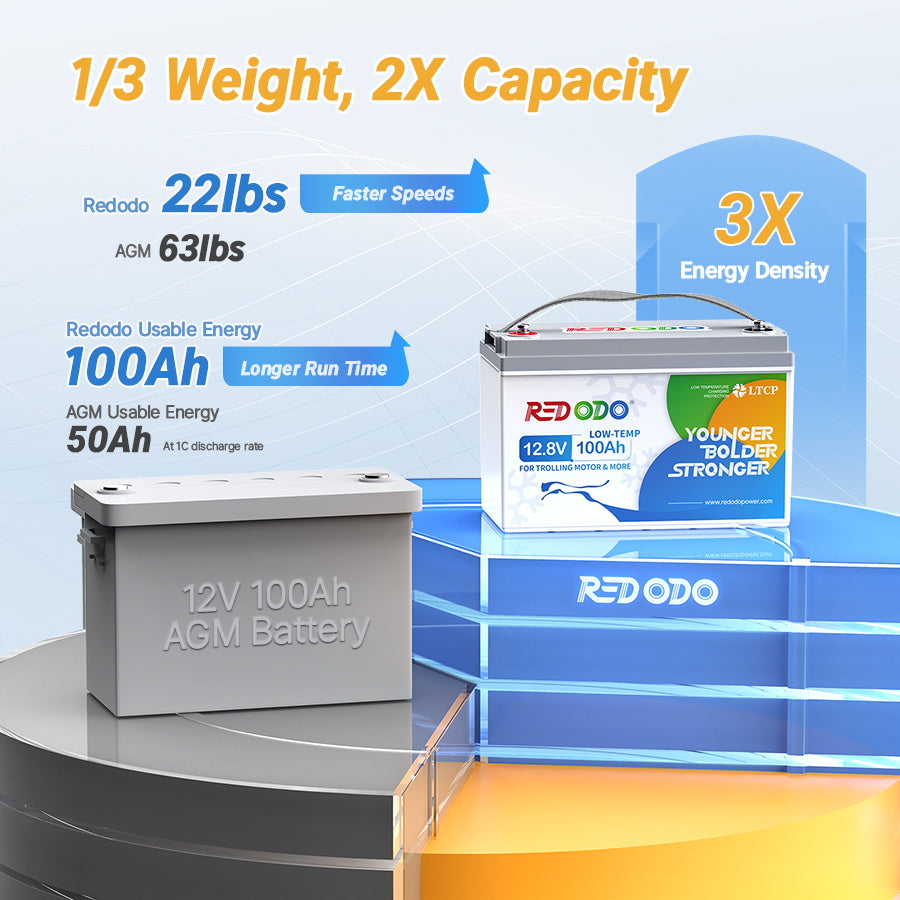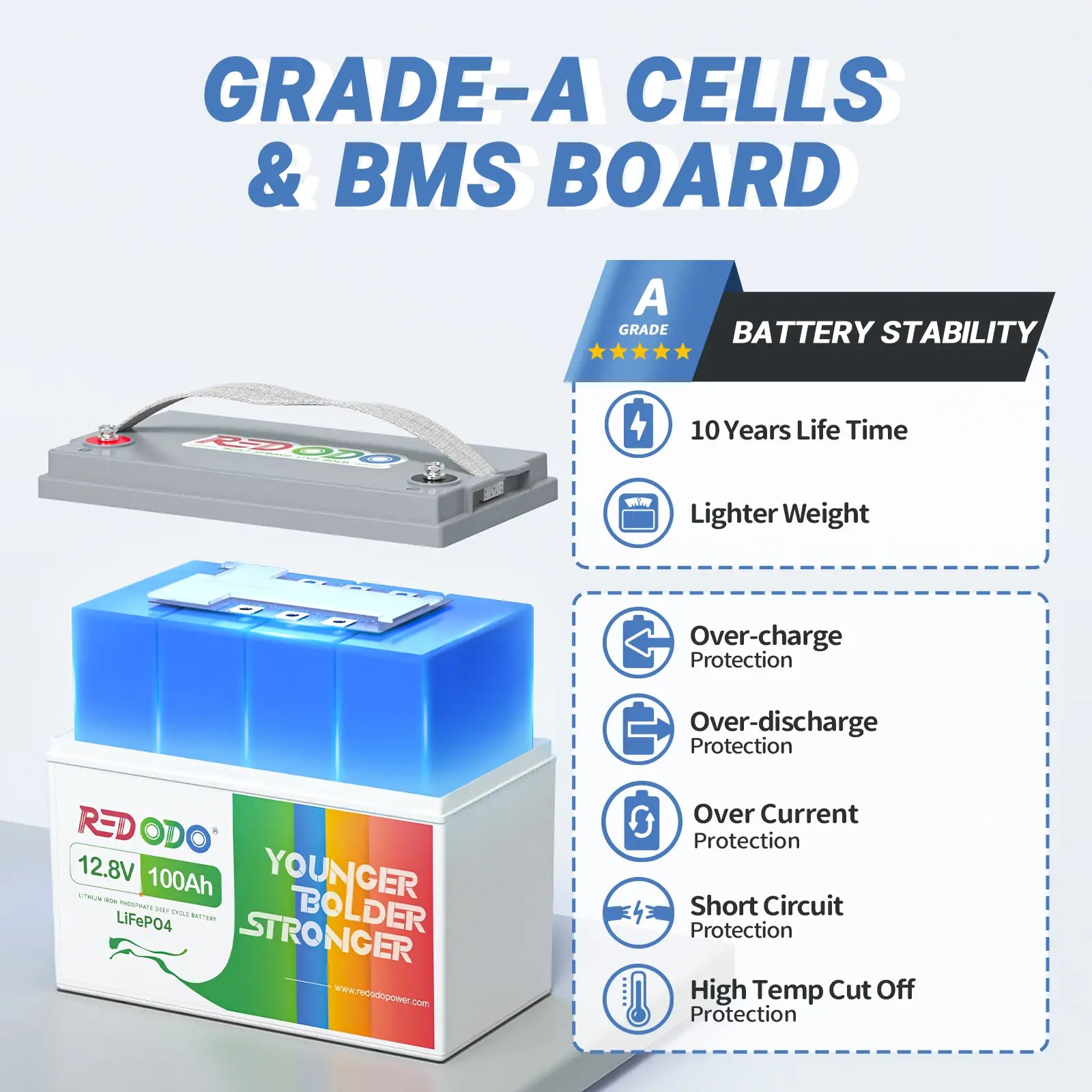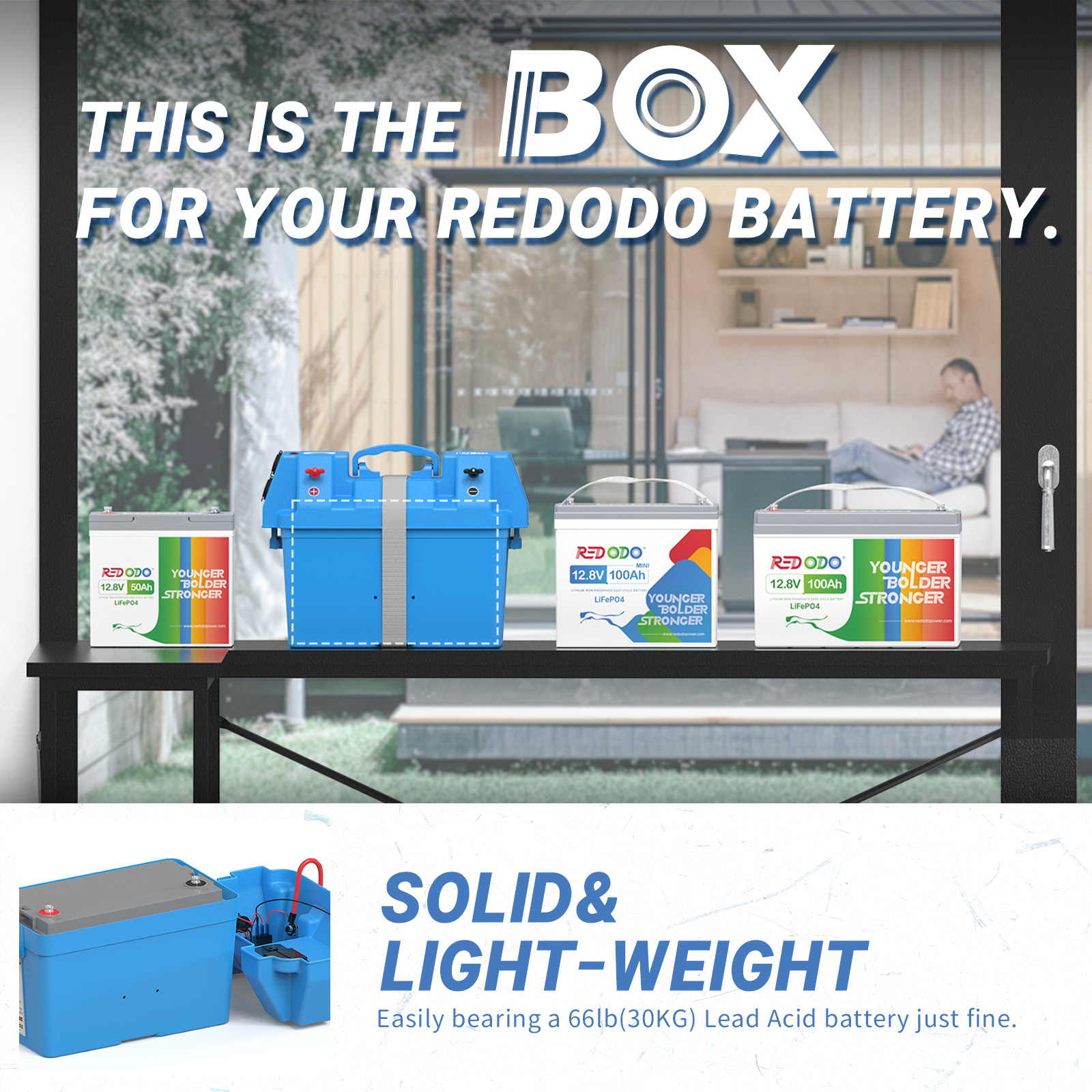The Full Comparison of Group 24 VS Group 31 Deep Cycle Batteries
If you've ever done research or bought batteries, you might be aware of Group 24 and Group 31 deep cycle batteries. These batteries are well-known for their dependable performance. But, what sets them apart from each other?
In this evaluation, we will closely examine the features, benefits, and drawbacks of Group 24 and Group 31 batteries.
Table of Content
- What is A Deep Cycle Battery?
- What Does Group Size Mean?
- Features of AGM Group 24 & Group 31 Deep Cycle Batteries
- Lithium Group 24 & Group 31 LiFePO4 Batteries Break the Limitation
- Group 31 Lithium Battery with Low-Temperature & Self-Heating Protection
- FAQs about Group 24 VS Group 31 Battery
What is A Deep Cycle Battery?
A deep cycle battery is a type of battery designed to provide a steady and consistent flow of power over an extended period. Unlike starting batteries used in vehicles, which are designed for short bursts of high current to start the engine, deep cycle batteries are built to deliver a lower, sustained level of power over a longer duration.
Deep cycle batteries are commonly used in applications that require continuous power, such as recreational vehicles (RVs), boats, golf carts, renewable energy systems, and off-grid installations. These batteries are specially designed to handle repeated deep discharges and recharges, making them ideal for deep cycling applications.
What Does Group Size Mean?
Group size for batteries refers to a standardized code set by BCI that specifies the physical dimensions and terminal layout of a particular battery model. It ensures compatibility and proper installation into specific vehicles.

Group size does not directly indicate the battery's capacity or performance. Instead, it primarily determines the battery's physical dimensions and terminal placement, which must match the requirements of the vehicle's battery compartment.
Check out all the options available in our best LiFePO4 Batteries to meet your equipment requirements.
Features of AGM Group 24 & Group 31 Deep Cycle Batteries
1. Features of Group 24 Battery
Group 24 batteries are a popular choice in various applications, thanks to their unique features and capabilities. Here are some key features of Group 24 batteries:
Size and Compatibility
Group 24 batteries have a standardized size that makes them compatible with a wide range of equipment, such as RVs, boats, golf carts, and solar power systems. Their dimensions typically measure around 10.25 inches in length, 6.75 inches in width, and 9.25 inches in height.
Capacity and Power
Group 24 batteries are available in various capacities to suit different energy requirements. They typically offer a range of 75Ah to 100Ah, providing ample power for powering appliances, electronics, and other devices for extended periods.
Deep Cycle Design
Group 24 batteries are designed specifically for deep cycle applications, allowing for repeated discharge and recharge cycles without significant degradation in performance. This makes them ideal for applications that require sustained power output over a long period, such as marine and off-grid systems.
2. Features of Group 31 Battery
Deep cycle Group 31 batteries are known for their robust capabilities and suitability for demanding applications. Here are some key features of deep cycle Group 31 batteries:
Size and Compatibility
Group 31 batteries have a larger size compared to Group 24 batteries, offering higher capacity and power output. They are commonly used in applications such as boats, recreational vehicles (RVs), commercial vehicles, and off-grid systems. The dimensions of Group 31 battery typically measure around 13 inches in length, 6.7 inches in width, and 9.4 inches in height.
High Capacity and Power
Group 31 batteries have a larger capacity than Group 24 batteries, typically ranging from 100Ah to 130Ah or more. This higher capacity allows them to store and deliver more energy, making them suitable for applications that require extended periods of continuous power, such as powering multiple appliances or running heavy loads.
Deep Cycle Design
Similar to Group 24 batteries, Group 31 batteries are designed for deep cycle applications. They are capable of withstanding repeated deep discharges and recharges without significant loss of performance. This makes them particularly well-suited for applications like marine vessels, RVs, and off-grid energy systems where consistent power output is essential.
Durability and Resistance
Group 31 batteries are built to withstand rugged conditions, including vibration, shock, and rough handling commonly encountered in mobile and heavy-duty applications. They are constructed with robust materials and designs that ensure durability and reliability even in challenging environments.
Extended Cycle Life
Deep cycle Group 31 batteries can typically endure a higher number of charge-discharge cycles compared to other battery types. This extended cycle life results in a longer lifespan and makes them a cost-effective choice over the long term.

For detailed information and specifications, check out Redodo Group 31 Deep cycle Batteries.
Comparing Group 24 and Group 31 Batteries
Size and Weight
Group 24 batteries are generally smaller and lighter compared to Group 31 batteries. The specific dimensions and weights can vary slightly between different manufacturers, but Group 31 batteries are typically larger and heavier due to their higher capacity.
Capacity and Power
Group 31 batteries have a higher capacity and power output compared to Group 24 batteries. This means that Group 31 batteries can deliver more energy and sustain power for a longer duration. They are often preferred for applications that require higher power demands or longer runtimes.
Application
Group 24 batteries are commonly used in various applications, including small to medium-sized boats, recreational vehicles, and some off-grid installations. They are suitable for applications with moderate power demands.
Group 31 batteries are often found in larger boats, motorhomes, commercial vehicles, and off-grid systems that require higher power output. They are ideal for applications with higher energy requirements and prolonged battery use.
Price
Group 31 batteries are generally more expensive than Group 24 batteries due to their larger capacity and higher power output.
|
Features |
AGM Group 24 Battery |
AGM Group 31 Battery |
|
Standard Size (LxWxH) |
10.25″ x 6.8125″ x 8.875″ |
13″ x 6.8125″ x 9.4375″ |
|
Weight |
40-50 lbs |
60-70 lbs |
|
Capacity (20-hour rate) |
70-85 Ah |
95-125 Ah |
|
Lifespan |
3-5 years |
4-6 years impressive 15,000 cycles at 60% DOD. |
|
Cost |
Typically less expensive |
Typically more expensive |
Lithium Group 24 & Group 31 LiFePO4 Batteries Break the Limitation
With the introduction of advanced Group 24 and Group 31 LiFePO4 (Lithium Iron Phosphate) batteries, the traditional differences between these groups have been altered. LiFePO4 batteries offer several advantages over traditional AGM or lead-acid batteries, making them a popular choice for various applications.
Take Redodo 12V 100Ah Group 24 and Group 31 basic lithium battery for example.
Size & Weight
Redodo's LiFePO4 lithium batteries in Group 24 and Group 31 sizes are designed to adhere to the widely used BCI battery size standard, making them direct replacements for old AGM batteries.
Furthermore, Redodo lithium batteries are significantly lighter, weighing only 1/3 of AGM lead-acid batteries. The Group 31 battery weighs only 24.25 lbs, while the smaller Group 24 battery weighs 21 lbs.
Capacity and Lifespan
Both the Redodo Group 24 and Group 31 lithium batteries have a capacity of 100Ah and a nominal voltage of 12.8V. Redodo ensures the use of automotive quality LiFePO4 prismatic cells throughout its lithium battery portfolio.
These batteries are equipped with a powerful Battery Management System (BMS) that protects against overcharging, over-discharging, over-current, overheating, and short-circuiting. This advanced technology contributes to the batteries' consistent and dependable performance over their 10-year service life. Redodo batteries are capable of up to 4000 cycles at 100% depth of discharge (DOD), 6000 cycles at 80% DOD, and an impressive 15,000 cycles at 60% DOD.
Cost
Typically, lithium batteries come with a higher price tag compared to AGM or other lead-acid batteries. However, Redodo provides budget-friendly LiFePO4 lithium batteries that offer excellent value. Both the Group 24 and Group 31 batteries from Redodo are priced below $250. When considering the long-term use and benefits of lithium batteries, making the upgrade becomes a wise investment.
By choosing Redodo's LiFePO4 lithium batteries in either the Group 24 or Group 31 size, customers can enjoy the convenience of a direct replacement, significant weight reduction, high capacity, long lifespan, and cost-effective pricing. These batteries provide a reliable and efficient power solution for various applications, making them a smart choice for those seeking durable and high-performance energy storage.
|
Features |
Group 24 Battery |
Group 31 Battery |
|
Standard Size (LxWxH) |
10.23* 6.61* 8.22 inch |
13* 6.77* 8.43 inch |
|
Weight |
About 21 lbs |
About 25 lbs |
|
Nominal Voltage |
12.8V |
12.8V |
|
Capacity |
100 Ah |
100 Ah |
|
Lifespan |
10 years+ |
10 years+ |
|
Cost |
Around $250 |
Around $250 |
| Recommended Product |
Group 31 Lithium Battery with Low-Temperature & Self-Heating Protection
For individuals residing in regions with long winters, having a battery that offers low-temperature charging protection is crucial. The Redodo 12V 100Ah LOW-TEMP battery is specifically designed to address this need. Equipped with a 100A Battery Management System (BMS), this battery incorporates Low Temperature Charging Protection (LTCP) functionality.
With LTCP, the BMS actively monitors the battery temperature. When the temperature drops below 0°C/32°F, the BMS automatically halts the charging process, ensuring the battery is protected from potential damage that can occur during charging in low temperatures. Once the temperature rises above 5°C/41°F, the charging cycle resumes, allowing the battery to recharge effectively.
Shop Now: Redodo 12V Lithium Battery With Low Temp Protection
The other outstanding choice for cold weather is the Group 31 Self-heating Battery. Equipped with 100W dual heating pads, this battery automatically activates the internal heating function when the ambient temperature drops below 32°F (0°C). Once the temperature reaches 41°F (5°C), the heating stops, and the battery resumes normal charging.
This feature allows you to charge the battery efficiently without the risk of battery damage caused by cold temperatures. It's ideal for RVs, marine applications, solar setups, and off-grid living in wintery climates.
Shop Now: Redodo 12V 100Ah Self-Heating Deep Cycle Lithium Battery
FAQs about Group 24 VS Group 31 Battery
1. Can I replace a Group 24 battery with a Group 31 battery?
It depends on the specific application and compatibility of the battery compartment. Group 31 batteries are larger than Group 24 batteries, so you need to ensure that there is sufficient space to accommodate the larger size. Additionally, you need to consider the power requirements and capacity of your equipment to make sure the Group 31 battery can provide adequate power. It is always recommended to consult the equipment or vehicle manufacturer's specifications and guidelines or seek professional advice before making any battery replacements.
2. Which applications are suitable for Group 24 and Group 31 batteries?
Group 24 batteries are commonly used in smaller-scale applications such as small boats, motorcycles, utility vehicles, and smaller RVs. Group 31 batteries, due to their larger size and higher capacity, are typically employed in applications that require sustained power output, including larger boats, larger RVs, commercial vehicles, off-grid systems, and equipment with higher power demands.
Can I connect Redodo Group 24 and Group 31 lithium battery in series or paralle?
It is not recommended to connect Redodo Group 24 and Group 31 batteries in series or parallel configurations. This may result in overcharging or over-discharging one of the batteries. For optimal performance and safety, it's advisable to use batteries of the same brand, type, BMS, and capacity, and make sure the batteries are purchased in near time (within one month).
Conclusion
Lithium Group 24 and Group 31 breaks many limitations of traditional AGM batteries. The only difference is the size, so you can choose them based on your specific needs.
For battery protection, utilizing a battery box is a great way.
Read More:
Best Group 31 Trolling Motor & Deep Cycle Battery Review
Convert RV from Lead-Acid to Lithium Battery

Redodo

Redodo
Join Redodo
Related Post

How to Upgrade Travel Trailer Battery to Lithium?

How to Store a Deep Cycle Marine Battery for Winter?

What Size Solar Panel Do I Need to Charge A 12V Battery?

Light Up Your Christmas with Redodo: LiFePO4 Batteries Holiday Deals













